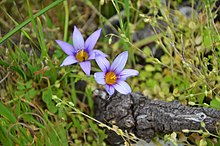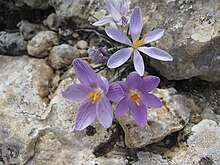en
names in breadcrumbs


Romulea columnae o azafrán del Guadiana,[1] ye una planta de la familia de les iridacees.
Flores pequeñes, lila claro o violetes, marielles escontra la base de 7-10 mm de diámetru, 1-3 en tarmu curtiu. Fueyes basales procedentes de 2 bulbos tuberosos con 1-6 fueyes caulinares, curties y erectas o llargues. Tubu corolino de 2,5-5,5 mm, segementos de 1-2 cm llanceolaos o oblanceolaos, agudos. El frutu brota percima del suelu. Floria en primavera.
En Gran Bretaña, Francia, España, Grecia, Italia, Portugal y Turquía. En praderíes seques en dunes y petones.[2]
Romulea columnae describióse por Sebast. & Mauri y espublizóse en Florae Romanae Prodromus 18 1818.[3]
Romulea: nome xenéricu que foi nomáu n'honor de Rómulo, el fundador de Roma na lleenda.[4]
columnae: epítetu llatín que significa "columnar"[5]
 Esta páxina forma parte del wikiproyeutu Botánica, un esfuerciu collaborativu col fin d'ameyorar y organizar tolos conteníos rellacionaos con esti tema. Visita la páxina d'alderique del proyeutu pa collaborar y facer entrugues o suxerencies.
Esta páxina forma parte del wikiproyeutu Botánica, un esfuerciu collaborativu col fin d'ameyorar y organizar tolos conteníos rellacionaos con esti tema. Visita la páxina d'alderique del proyeutu pa collaborar y facer entrugues o suxerencies. Romulea columnae o azafrán del Guadiana, ye una planta de la familia de les iridacees.
Romulea columnae és una planta de la família de les iridàcies. Fa unes flors petites, lila clar o violetes, grogues cap a la base de 7-10 mm de diàmetre, 1-3 en tija curt. Fulles basals procedents de dos bulbs tuberosos amb 1-6 fulles caulinars, curtes i erectes o llargues. La flor té una corol·la tubular de 2,5-5,5 mm, segments d'1-2 cm lanceolats o oblanceolats, aguts. El fruit aflora per sobre del terra. Floreix a la primavera. Habita en praderies seques en dunes i esculls de Gran Bretanya, França, Espanya, Grècia, Itàlia, Portugal i Turquia.[1]
Romulea columnae és una planta de la família de les iridàcies. Fa unes flors petites, lila clar o violetes, grogues cap a la base de 7-10 mm de diàmetre, 1-3 en tija curt. Fulles basals procedents de dos bulbs tuberosos amb 1-6 fulles caulinars, curtes i erectes o llargues. La flor té una corol·la tubular de 2,5-5,5 mm, segments d'1-2 cm lanceolats o oblanceolats, aguts. El fruit aflora per sobre del terra. Floreix a la primavera. Habita en praderies seques en dunes i esculls de Gran Bretanya, França, Espanya, Grècia, Itàlia, Portugal i Turquia.
Romulea columnae ist eine Pflanzenart aus der Familie der Schwertliliengewächse (Iridaceae). Sie ist im Mittelmeerraum beheimatet.
Romulea columnae ist eine krautige Pflanze, die eine Wuchshöhe von 2 bis 15 Zentimeter erreicht. Die eiförmige bis annähernd kugelförmige Knolle ist 1 bis 1,5 Zentimeter lang und umgeben von einer braunen Außenhaut, die zum oberen Ende hin abbricht. Die Blätter sind halbzylindrisch, fest und aufrecht oder um die Pflanze herum ausgebreitet.[1]
Der anfangs 4 bis 6 Zentimeter messende, sich später aber noch verlängernde Blütenstand ist meist ein-, selten zwei- bis dreiblütig. Das untere Hochblatt ist vollständig krautig, das obere bis auf die Mittelrippe häutig. Das Perigon misst 10 bis 12 Millimeter, die Blütenröhre misst ein Drittel der gesamten Blütenhüllblätter. Der Schlund ist unbehaart und mit einem gelben Schlundfleck versehen, das freie Ende der Blütenhüllblätter ist gelb oder violett mit dunklerer Zeichnung, am äußeren Ende spitz bis stumpf. Die Staubblätter sind halb so lang wie die Blütenhülle, der Griffel überragt die Staubblätter nicht.[1]
Die Chromosomenzahl beträgt 2n = 60.[2]
Die Art ist rund um das Mittelmeer und in Teilen Westeuropas verbreitet[2]. Die stenöke Art besiedelt dort Viehweiden, Gebüschen und Lichtungen, aber auch trockene Felsen[2] in Höhenlagen von 0 bis 1200 Meter.[1]
Die Art wurde 1818 erstbeschrieben, der Artname ehrt den italienischen Botaniker Fabio Colonna. Je nach Autor werden verschiedene Untertaxa unterschieden, die Art gilt als noch unzureichend bearbeitet[3]. So finden sich beispielsweise Romulea ramiflora, Romulea melitensis und Romulea rollii als Varietäten zu Romulea columnae gestellt[2] oder es wird Romulea assumptionis als Unterart[3] verstanden, andere Werke hingegen fassen jede der Taxa als selbständige Arten auf[1]. Hier wird der Flora Europaea[4] gefolgt, nach der nur Romulea rollii als Unterart von Romulea columnae verstanden wird:
Hinzu kommt allerdings noch:
Und außerhalb Europas:
Romulea columnae ist eine Pflanzenart aus der Familie der Schwertliliengewächse (Iridaceae). Sie ist im Mittelmeerraum beheimatet.
Romulea columnae, the sand crocus, is a herbaceous perennial in the family Iridaceae. It is a small plant, with thin narrow leaves, and small scape which has small pink, pale purple or violet pointed flowers with darker veining and a gold or yellow throat. It is native to a wide area ranging from western Europe to the Mediterranean.
Romulea columnae grows from a small corm.[3][4] It has one or two basal leaves,[5] and several (up to 3,[4]) cauline (stem) leaves,[3] They are narrow, wiry and curled,[3][4][5] and they can grow up to 10 cm (4 in) long.[4][5][6] Plants from the Romulea genus are related to members of the crocus genus and look very similar but have several differences, including that Romulea plants do not have the traditional crocus feature of having a white grove in the centre of their leaves.[7] Also that crocus flowers are stemless and grow directly from the corm, where as Romulea plants hold their flowers on a green scape of various lengths. Romulea columnae has a short scape,[3] of up to 3–20 cm (1–8 in) long.[4][5][7] In the UK, it is only between 3–4 cm (1–2 in) tall.[4][5]
It blooms early in the year, from February onwards,[3] or between March and May.[4][5] It has one to three flowers to a corm,[3][5] most common is a solitary flower,[5] which is small and only reaching between 10 and 12 mm across.[4] The flowers are funnel-shaped,[3] and have 6 pointed (at the tip) petals,[4][5] which are equally-sized.[5] They are pink,[5] pale purple,[4][5][6] or violet.[3] They are greenish-yellow,[5] yellow,[4] or golden-yellow at the centre or throat.[3] They have purple,[4][6] or violet veins or a dark midvein and a pair of lighter lateral veins.[5] It has a green spathe which is thin and spindly.[4] It has three stamens, topped by yellow,[5] or bright yellow anthers,[4] and the style is shorter than the stamens.[6]
It reproduces mostly by making seed.[4]
It is commonly known as sand crocus[3][5] and occasionally as dune crocus,[8] In Malta, it is known as the Lesser sand crocus due to another endemic Romulea species.[9]
The Latin specific epithet columnae refers to column.[10]
It was published and described by 2 Italian botanists, Francesco Antonio Sebastiani and Ernesto Mauri in 'Fl. Roman. Prodr.' vol.18 in 1818.[11][12][13]
Romulea columnae was verified by United States Department of Agriculture Agricultural Research Service on 4 April 2003,[12] and it is an accepted name by the RHS.[14]
There are 4,[1] or 2 known subspecies (grandiscapa and rollii);[2]

Romulea columnae is native to various temperate areas of western Asia,[14] Africa and Europe.[12][13][1]
Within Africa, it is found in Macaronesia, (within the Madeira Islands, Canarias[13][1]), Algeria, Morocco and Tunisia.[12] It is found in the Asian countries of Cyprus, Israel, Lebanon, Syria and western Turkey.[12] Within Europe,[7][3] it is found in south west England, Greece (including Crete), Italy (including the isles of Sardinia and Sicily), France (including the island of Corsica), Spain (including the Balearic Islands) and Portugal.[12]
It has naturalized with the Azores.[12]
It is found growing on free draining sandy soils that make up coastal cliffs slopes,[10] and coastal grasslands.[5][22] It can grow on sandy grounds near the sea.[4] Including on golf courses,[8] such as Dawlish Warren course in Devon,[23] which is classified as a Site of Special Scientific Interest (SSSI).[24]

In temperate gardens, it is best to grow the plant inside a temperature controlled Alpine house, it can be grown in containers filled with well-drained, loam-based compost. The plant is allowed to dry in summer after the flowers have faded and the leaves become yellow.[3]
Romulea columnae, the sand crocus, is a herbaceous perennial in the family Iridaceae. It is a small plant, with thin narrow leaves, and small scape which has small pink, pale purple or violet pointed flowers with darker veining and a gold or yellow throat. It is native to a wide area ranging from western Europe to the Mediterranean.
Romulea columnae o azafrán del Guadiana,[1] es una planta de la familia de las iridáceas.
Flores pequeñas, lila claro o violetas, amarillas hacia la base de 7-10 mm de diámetro, 1-3 en tallo corto. Hojas basales procedentes de 2 bulbos tuberosos con 1-6 hojas caulinares, cortas y erectas o largas. Tubo corolino de 2,5-5,5 mm, segementos de 1-2 cm lanceolados u oblanceolados, agudos. El fruto brota por encima del suelo. Florece en primavera.
En Gran Bretaña, Francia, España, Grecia, Italia, Portugal y Turquía. En praderas secas en dunas y arrecifes.[2]
Romulea columnae fue descrita por Sebast. & Mauri y publicado en Florae Romanae Prodromus 18 1818.[3]
Romulea: nombre genérico que fue nombrado en honor de Rómulo, el fundador de Roma en la leyenda.[4]
columnae: epíteto latín especie dedicada a Fabius Columna (1567-1640), botánico italiano.[5]
Romulea columnae o azafrán del Guadiana, es una planta de la familia de las iridáceas.
La romulée à petite fleurs, Romulea columnae, est une espèce de plantes herbacées bulbeuse appartenant à la famille des Iridaceae et au genre Romulea.
Romulea columnae pousse sur les sols sablonneux drainants des prairies et des falaises côtières du littoral méditerranéen et atlantique depuis le Maroc, les Canaries jusqu'en Grande-Bretagne.
La romulée à petite fleurs, Romulea columnae, est une espèce de plantes herbacées bulbeuse appartenant à la famille des Iridaceae et au genre Romulea.
Romulea columnae é uma espécie de planta com flor pertencente à família Iridaceae.
A autoridade científica da espécie é Sebast. & Mauri, tendo sido publicada em Florae Romanae Prodromus exhibens centurias xii Plantarum 18. 1818.[1]
Trata-se de uma espécie presente no território português, nomeadamente os seguintes táxones infraespecíficos:[2]
Romulea columnae é uma espécie de planta com flor pertencente à família Iridaceae.
A autoridade científica da espécie é Sebast. & Mauri, tendo sido publicada em Florae Romanae Prodromus exhibens centurias xii Plantarum 18. 1818.
Romulea columnae là một loài thực vật có hoa trong họ Diên vĩ. Loài này được Sebast. & Mauri miêu tả khoa học đầu tiên năm 1818.[1]
Romulea columnae là một loài thực vật có hoa trong họ Diên vĩ. Loài này được Sebast. & Mauri miêu tả khoa học đầu tiên năm 1818.